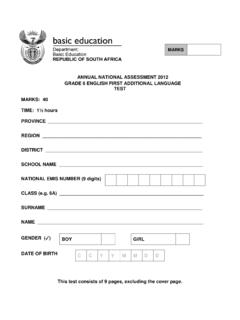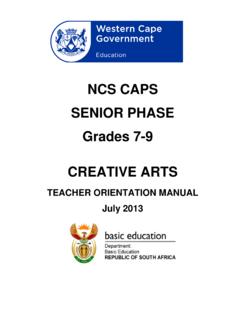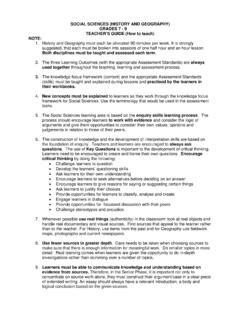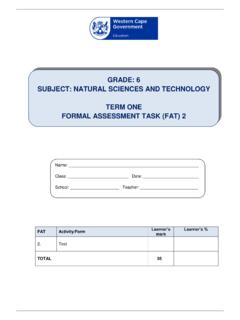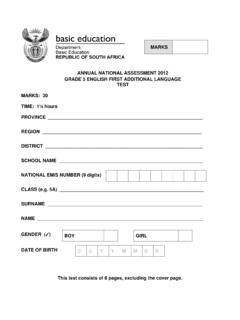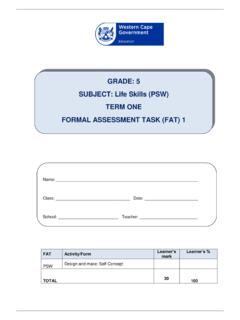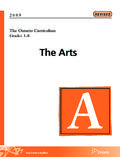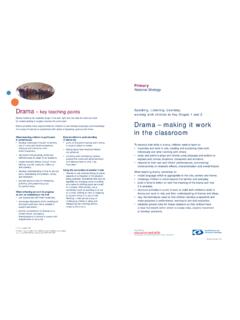Transcription of CREATIVE ARTS TEACHING PREPARATION
1 1 | P a g e CREATIVE ARTS TEACHING PREPARATION GRADE 7 TERM 1: DANCE Wk What to teach How to teach Resources, writing and homework activities Text book page nr. 1 Topic1: Dance Performance Dance Conventions: setting a safe environment, conventions for entering and leaving and code of conduct, dress code Warm Up: walking, running with freezes using shape, level and direction Cooling down Topic 2: Dance Improvisation and Composition Elements of Dance: use of space, shape, levels and direction Topic 3: Dance Theory and Literacy Dance terminology Importance of Warm up Individually and in pairs doing a mirror image activity Individually doing everyday movements to introduce locomotors Body, space, music 2 Topic1: Dance Performance Dance Conventions: add respect and sensitivity to others and trust exercises Warm up: Introduction to principles of posture and alignment while continuing activity as before Cooling down Topic 2: Dance Improvisation and Composition Elements of Dance.
2 Use of space, shape, levels and direction adding dimension and pathways Topic 3: Dance Theory and Literacy Continue from previous week Pairs Individually exploring locomotor movements Body, space, music, props 2 | P a g e 3 Topic1: Dance Performance Dance Conventions: continue Warm up now using variation in shape, level and direction Introduction to floor work for core stability, strength and flexibility emphasising good posture and alignment: flexing and stretching the feet Cooling down Topic 2: Dance Improvisation and Composition Continue exploring elements of dance using time and force Topic 3: Dance Theory and Literacy Importance of good posture and Alignment Individual activity seated on the floor Body, space, music Worksheets 4 Topic1: Dance Performance Warm up Floor work adding the rounding and lengthening of the spine Joint mobility: knee bends, rises and transference of weight from side to side Topic 2: Dance Improvisation and Composition Continue exploring dance elements: relationships Topic 3: Dance Theory and Literacy Dance terminology Individually Pairs Body, space, music 5 Topic1: Dance Performance Warm up Joint mobility and transference of weight continues PREPARATION for safe landing from movements of elevation/aerial movements: small jumps Cooling down with safe stretching Topic 3: Dance Theory and Literacy Dance terminology Individually and in pairs Body, space, music 3 | P a g e 6 Topic1: Dance Performance Warm up Floor work Joint mobility and transference of weight Activity for jumps Simple locomotor combinations across space Cool down continues Topic 3.
3 Dance Theory and Literacy Continues Individually Body, space, music 7 Topic1: Dance Performance Warm up Class work Cooling down Topic 2: Dance Improvisation and Composition Elements of dance: focusing on time, tempo, accents phrasing using body percussion, stamps and claps Topic 3: Dance Theory and Literacy Discussion on elements of space and time Individually Groups creating own compositions Body, space, music 8 Topic1: Dance Performance Warm up Class work for the FAT (Formal Assessment Task) Cool down Topic 2: Dance Improvisation and Composition Elements of dance: focusing on time, tempo, accents phrasing using body percussion, stamps and claps Individually Groups Body, space, music 4 | P a g e 9 Topic1: Dance Performance Class work continues as before Topic 2: Dance Improvisation and Composition Composition exploring Elements of dance Individually Groups Body, space, music 10 Formal Practical Assessment Task (FAT): Dance Performance FAT: 50 marks converted to 10 Individually and in groups Body, space, music, props 5 | P a g e CREATIVE ARTS TEACHING PREPARATION GRADE 7 TERM 1: drama Wk What to teach How to teach Resources, writing and homework activities Text book page nr.
4 1 Topic 1:Voice & Physical development Voice: relaxation, breathing exercises Physical: release tension, mirror work Topic 2: Playmaking (improvised drama ) Commence with development of short improvisation(use themes relevant to learners). Provide and explore stimulus pictures, photographs, stories, anecdotes, one-liners. Individually and in pairs. Divide class in groups of five. Provide stimulus that will lead to improvised drama . Group and teacher facilitated discussion. Voice, body, space. Photographs, pictures, stories, anecdotes, strips of paper with interesting, with catchy sentences. 2 Topic 1: Voice & Physical development Voice: relaxation, breathing, resonance exercises (cont.) Physical: use imagery to warm-up the body. Topic 2: Playmaking (improvised drama ) Develop storyline with beginning, middle and end. Focus on Who, What, Where, When. Individually and in pairs. In groups. Develop storyline in workbooks, using mind maps and write story in full.
5 3 Topic 1: Voice & Physical development Voice: relaxation, breathing, resonance exercises (cont.) Individually and in pairs. 6 | P a g e Physical: use imagery to warm-up the body (cont.) Topic 2: Playmaking (improvised drama ) Shape and develop scenes using tableaux. Reflection notes in workbooks. Design picture frames showing the various tableaux. 4 Topic 1: Voice & Physical development Voice: relaxation, breathing, articulation exercises (cont.) Physical: explore movement dynamics. Topic 2: Playmaking (improvised drama ) Develop characters, space, theme and message of drama . Individually and in pairs. Teacher facilitated developmental work in groups. Workbooks: Character, theme and message collage. 5 Topic 1: Voice & Physical development Voice: relaxation, breathing, articulation exercises (cont.) Physical: explore movement dynamics (cont.) Topic 2: Playmaking (improvised drama ) Explore physical relationships in space, focus points, levels, and proximity of characters to each other.
6 Consider where the audience is seated. Individually and in pairs. Teacher facilitated developmental work in groups. Basic stage design in workbooks. 6 Topic 1: Voice & Physical development Voice: relaxation, breathing, articulation exercises (cont.) Physical: explore movement dynamics (cont.) Topic 2: Playmaking (improvised drama ) Focus of listening and concentration, action and reaction. Practise the scene, refining it for performance (homework rehearse own Individually and in pairs. Teacher facilitated developmental work in Self-reflection in workbooks: Journal, self-reflection worksheet. 7 | P a g e part and if possible in group to prepare for formal practical assessment in weeks 8 and 9)). groups. 7 Topic 5: Careers Research careers of actors/dancers /singers/clowns/ stand-up comedians. Learners select career of performing artist to be explored in class. Notes, websites, HEI brochures, books, magazines articles, newspapers used as sources for careers.
7 8 Topic 5: Careers Research careers of actors/dancers /singers/clowns/ stand-up comedians. Learners select career of performing artist to be explored in class. Notes, websites, HEI brochures, books, magazines articles, newspapers used as sources for careers. 9 Formal Practical Assessment: Classroom improvised drama Groups perform their dramas, rest of the class complete critical reflection worksheet on the dramas they view. Critical reflection on classroom improvised dramas. 10 Formal Practical Assessment Task (FAT): Classroom improvised drama FAT: 50 marks converted to 10 Groups perform their dramas, rest of the class complete critical reflection worksheet on the dramas they view. Critical reflection on classroom improvised dramas. 8 | P a g e CREATIVE ARTS TEACHING PREPARATION GRADE 7 TERM 1: MUSIC Wk What to teach How to teach Resources, writing and homework activities Text book page nr.
8 1 Topic 1: Music literacy:- Letter names of notes on the treble cleft. Revision of the concept of note values (already covered in Grades 4-6) and cover all note values. Clapping or drumming short rhythmic phrases that use crotchets, minims and quavers Revision of stave, treble clef and position of Letter Names with relation to the lines and spaces. Consolidation of Letter Names and the notes on the lines and spaces Written exercise practising treble clef (at beginning of stave) and position of the Letter Names. Consolidation of crotchets, minims and quavers. Use non melodic instruments or body percussion to consolidate rhythmic patterns in a practical fun way. Music Literacy quizzes to consolidate concepts learned during first week (written sheet). Sheet with stave (five lines on which music is written) Poster with stave and treble cleft Flashcards with crotchets, minims and quavers, semibreves, semiquavers Poster with short rhythmic patterns (for drumming Drums, sticks, maracas, tambourines, (any non- melodic musical instrument) 2 Pitch:- Sight singing melodic phrases from known and unknown songs using tonic sol-fa.)
9 Following musical scores while listening to music. Duration : Introduction of the dotted note, also in relation to : Revision of tonic- solfa through songs. Group activity: - Learners listen to songs and sing along. Identify how high or low the sounds are (pitch). Practical consolidation/ revision of treble and bass clef as well as crotchets, quavers, minims using rhythmic patterns and well known songs. Explain and introduce the dotted notes by using flashcards (minims, crotchets, etc.) Consolidating Letter names of notes focusing on Poster /copy of short well known songs CD player with selected songs. Flashcards with minims, crotchets etc. 9 | P a g e o crotchets o quavers o minims o semibreves o dotted minim Treble and bass clef Duration: consolidation of content learned. Letter names of notes on the treble and bass cleft Clapping or drumming polyrhythmic phrases their position (changes) because of the treble and bass clefs in front respectively.
10 Sing and clap above notes to illustrate duration. Provide written notes on above as well as short written test. 3 Topic 2: Music listening:- Listening to performed music and identifying or describing the: o beats including-duple (two beats), triple (three beats) and quadruple (four beats) meter o instruments used in the performance. o the story the music is telling (sad/happy, recognising a dance, march, etc. Following simple musical scores while listening to music. Active listening to a variety of recorded or live music by clapping or humming or moving. Playing a variety of songs for learners to listen and identifying the different beats (2/4, 3/4, 4/4 etc.), meter. Questionnaire for group and individual listening. Informal discussion on piece and general information (group work) Leading learners in following musical scores while listening to music. Highlight certain areas you want them to focus on.)



